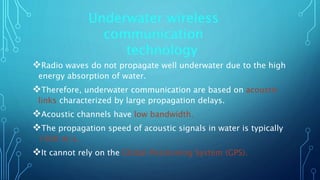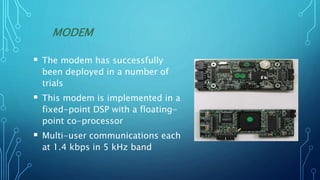Underwater wireless communication
- 1. By- Abhirami P S BCA Assumption College
- 2. INTRODUCTION Wireless communication technology today has become part of our daily life. It is difficult due to factors such as multi-path propagation, time variations of the channel, small available bandwidth and strong signal attenuation especially over long distance. Underwater communications uses acoustic waves instead of electromagnetic waves.
- 3. HISTORY • The science of underwater acoustics began in 1490, when Leonardo Da Vinci ,stated. In 1687 Isaac Newton wrote his Mathematical Principles of Natural Philosophy which included the first mathematical treatment of sound in water.
- 4. COMMUNICATION CHANNEL The signals that are used to carry digital information through an underwater channel are acoustic signals An underwater acoustic channel presents a communication system designer with many difficulties The signal is subject to multipath propagation, which is particularly pronounced on horizontal channels
- 5. DEFICIENCY IN CURRENT COMMUNICATION Radio waves propagated under water at extremely low frequencies (30Hz-300Hz) & require large antennae and high transmission power. Optical waves do not suffer much attenuation but are affected by scattering. Acoustic waves are the single best solution for communicating underwater.
- 6. Radio waves do not propagate well underwater due to the high energy absorption of water. Therefore, underwater communication are based on acoustic links characterized by large propagation delays. Acoustic channels have low bandwidth. The propagation speed of acoustic signals in water is typically 1500 m/s. It cannot rely on the Global Positioning System (GPS). Underwater wireless communication technology
- 7. UNDERWATER NETWORKS o Integrated networks of instruments, sensors, robots and vehicles will operate together in a variety of underwater environments o Depending on the application there two types of Acoustic network
- 8. Centralized network, nodes communicate through a base station that covers one cell In a decentralized network, nodes communicate via peer-to-peer To accommodate multiple users within a selected network topology, the communication channel must be shared Methods for channel sharing are based on scheduling or on contention Centralized network topology Decentralized network topology
- 9. MODEM The modem has successfully been deployed in a number of trials This modem is implemented in a fixed-point DSP with a floating- point co-processor Multi-user communications each at 1.4 kbps in 5 kHz band
- 10. Autonomous underwater vehicle (AUV) is a robot that travels underwater Modem’s fit easily into the AUV Low power consumption Very reliable for high level throughput Autonomous underwater vehicle (AUV)
- 11. FACTORS INFLUENCING ACOUSTIC COMMUNICATION Path loss : Due to attenuation and geometric spreading. Noise : Man-made noise and ambient noise(due to hydrodynamics). Multi-path propogation. High propogation delay.
- 12. ADVANTAGES Can be used to provide early warnings of tsunamis generated by undersea earthquakes. It avoids privacy leakage. Pollution monitoring.
- 13. DISADVANTAGES Battery power is limited and usually batteries can not be recharged easily. The available bandwidth is severely limited. High bit error rate. Multipath problems.
- 15. CONCLUSION o The aim of this is to build a acoustic communication as in figure o This topic gives the overall view of the necessity of underwater wireless communication and its applications.
















